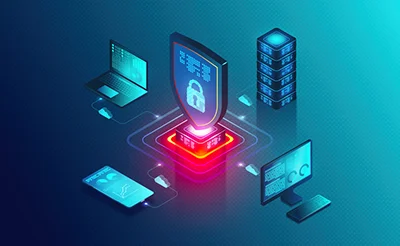Benefits of EDR
Endpoint Detection and Response (EDR) systems represent a significant evolution in cybersecurity, offering businesses and organizations a dynamic approach to detecting, analyzing, and responding to emerging threats. Integrating EDR into an organization’s cybersecurity strategy can bring numerous benefits, significantly enhancing its overall security posture. Below are some key advantages:
1. Enhanced Threat Detection Capabilities
EDR solutions provide a comprehensive view of endpoint activities, surpassing the capabilities of traditional antivirus software. By utilizing advanced technologies like behavioral analysis, artificial intelligence (AI), and machine learning, EDR systems can detect a broader range of threats, including zero-day attacks, ransomware, and advanced persistent threats (APTs). This detection level is vital in today's fast-evolving threat landscape, where new and sophisticated threats emerge constantly.
2. Real-time Response and Mitigation
One of the standout features of EDR systems is their ability to respond to threats in real time. Upon detecting a threat, EDR tools can immediately isolate infected endpoints, preventing the spread of malware across the network. They can also automatically initiate remediation processes, such as deleting malicious files or terminating harmful processes, thereby minimizing damage and reducing downtime.
3. Detailed Forensic Analysis and Insight
EDR solutions collect and analyze vast amounts of data from endpoints, offering in-depth insights into security incidents. This data includes information on when and how a threat entered the system, its behavior within the network, and the extent of the damage. Detailed forensic analysis is crucial for understanding attack vectors, improving security measures, and preventing future breaches.
4. Improved Incident Response Times
With EDR, organizations can significantly reduce the time it takes to detect and respond to security incidents. Traditional security measures often rely on manual intervention, which can be time-consuming and inefficient. In contrast, EDR systems automate many aspects of the detection and response processes, enabling security teams to address threats more swiftly and effectively.
5. Continuous Monitoring and Endpoint Visibility
Continuous monitoring is a core component of EDR, allowing for the constant surveillance of all endpoint activities. This continuous oversight provides security teams complete visibility into endpoint health and security status, enabling them to identify suspicious activities and vulnerabilities promptly. Such visibility is essential for maintaining control over an organization’s network and ensuring all endpoints comply with security policies.
6. Scalability and Flexibility
EDR systems are designed to adapt to the changing needs of organizations. Whether an organization grows in size or shifts its operational model, EDR solutions can scale accordingly. This scalability ensures that businesses of all sizes and industries can protect their endpoints effectively, regardless of their specific requirements or challenges.
7. Enhanced Regulatory Compliance
Many industries are subject to strict regulatory requirements regarding data protection and cybersecurity. EDR systems can help organizations meet these requirements by providing comprehensive security features, detailed reporting capabilities, and audit-ready logs. By ensuring that endpoints are continuously monitored and protected, EDR assists organizations in complying with GDPR, HIPAA, and PCI-DSS regulations.
Integrating Endpoint Detection and Response systems into an organization’s cybersecurity framework offers many benefits, from improved threat detection and real-time response to enhanced forensic analysis and regulatory compliance. EDR enables organizations to combat modern cyber threats more effectively and maintain a strong security posture by providing detailed visibility into endpoint activities and automating critical security processes. As cyber threats continue to evolve, the role of EDR in protecting digital assets and infrastructure will only become more pivotal.
How to Choose the Right EDR Solution
Choosing the right Endpoint Detection and Response (EDR) solution is crucial for ensuring the security and integrity of an organization's network and data. With numerous EDR solutions available in the market, selecting one that best fits your organization's needs can be challenging. Here are several factors to consider when choosing the right EDR solution:
Detection Capabilities
The primary purpose of an EDR solution is to detect threats that traditional security tools might miss. When evaluating EDR platforms, consider their ability to detect a wide range of threats, including zero-day exploits, ransomware, and advanced persistent threats. Look for solutions that leverage advanced technologies such as machine learning, artificial intelligence, and behavioral analytics to provide comprehensive threat detection.
Response and Remediation Features
A robust EDR solution should detect threats and provide effective response and remediation capabilities. Examine the tools and options for responding to detected threats, such as isolating infected endpoints, removing malicious files, and reversing unauthorized changes. An ideal EDR solution should enable automatic responses to common threats while allowing manual intervention in more complex cases.
Integration with Existing Infrastructure
The EDR solution should seamlessly integrate with your security infrastructure, including firewalls, antivirus programs, and other cybersecurity tools. Integration enhances the overall effectiveness of your security posture by enabling comprehensive data sharing and coordinated responses across different platforms.
Scalability and Flexibility
Your EDR solution should be scalable to accommodate the growth of your organization. It should be flexible enough to adapt to changing security needs and evolving threat landscapes. Consider solutions that offer customizable policies, adjustable alert thresholds, and the ability to add or remove endpoints without significant disruption.
User Interface and Usability
The user interface (UI) of the EDR platform should be intuitive and user-friendly, enabling security teams to monitor threats, analyze data, and implement responses efficiently. A well-designed UI can significantly reduce the learning curve and improve the efficiency of security operations.
Forensic Analysis and Reporting
Look for EDR solutions that provide comprehensive forensic analysis tools and detailed reporting capabilities. These features are essential for understanding the nature and scope of attacks, identifying vulnerabilities, and improving security measures. Reporting should also support compliance requirements by documenting incidents and responses.
Vendor Reputation and Support
Research the reputation of EDR vendors and the quality of their customer support. Look for reviews, case studies, and testimonials from other users. A reputable vendor should offer robust technical support, including 24/7 assistance, training resources, and regular updates to keep the software effective against the latest threats.
Cost Considerations
While cost should not be the sole determining factor, considering the EDR solution's pricing structure for your budget is essential. Evaluate the total cost of ownership, including initial setup fees, subscription costs, and any additional charges for updates or support. Ensure the investment aligns with the expected benefits and fits within your organization’s security budget.
Selecting the right EDR solution requires careful consideration of various factors, including detection capabilities, response features, integration with existing systems, scalability, usability, forensic and reporting capabilities, vendor reputation, and cost. By thoroughly evaluating these aspects, organizations can choose an EDR solution that effectively protects their endpoints and enhances their overall cybersecurity posture.
EDR FAQ
Endpoint Detection and Response (EDR) is a cybersecurity solution designed to continuously monitor endpoint devices (such as computers, mobile devices, and servers), identify potential threats, and respond to security incidents. EDR platforms collect and analyze data from endpoints to detect suspicious activities, provide tools for investigating threats, and offer capabilities to mitigate or remediate breaches. EDR aims to provide a deeper level of security beyond traditional antivirus software by identifying and responding to advanced threats and malicious behaviors.
While traditional antivirus software relies primarily on signatures to identify known malware, EDR solutions employ more advanced techniques, such as behavioral analysis, machine learning, and artificial intelligence, to detect a broader range of threats, including zero-day exploits and advanced persistent threats (APTs). Unlike antivirus software, EDR provides continuous monitoring and recording of endpoint activities, enabling detailed forensic analysis and real-time response to incidents. Additionally, EDR solutions offer greater visibility into the state of endpoints and can identify threats based on anomalous behaviors rather than relying solely on known malware signatures.
EDR can benefit organizations of all sizes and types, particularly those that handle sensitive data or are subject to regulatory compliance requirements. However, the suitability of EDR depends on the organization’s specific security needs, resources, and infrastructure. Small businesses might find some EDR solutions too complex or resource-intensive, while larger enterprises may require the advanced features and scalability EDR offers. Organizations should assess their threat landscape, IT environment, and security capabilities when considering an EDR solution to ensure it aligns with their cybersecurity strategy and operational requirements.

